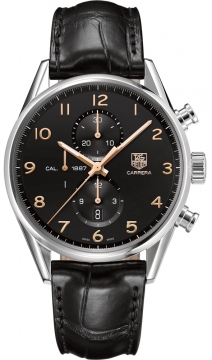
Inside this Carrera is TAG Heuer's in-house Calibre 1887, though
that "in-house" does require a bit of an explanation in this case.
Before we get into that story though, let's take a look at what the
Calibre 1887 does.
The 1887 is TAG Heuer's basic in-house chronograph movement. The balance beats at 4 Hz, the power reserve is approximately 50 hours (40 or so if you're using the chronograph a lot), and it is wound automatically by a full sized rotor. There are subdials for running seconds, a 30-minute chronograph register, and a 12-hour chronograph register, as well as a small date wheel. Importantly, the chronograph itself utilizes a column wheel instead of a lesser clutch.
The 1887 is TAG Heuer's basic in-house chronograph movement. The balance beats at 4 Hz, the power reserve is approximately 50 hours (40 or so if you're using the chronograph a lot), and it is wound automatically by a full sized rotor. There are subdials for running seconds, a 30-minute chronograph register, and a 12-hour chronograph register, as well as a small date wheel. Importantly, the chronograph itself utilizes a column wheel instead of a lesser clutch.
Named for the year that Heuer invented the oscillating pinion to be
used in stopwatches, the 1887 is the fourth in-house movement from TAG
Heuer - Calibre 360, Calibre S, and Calibre V came earlier. When it was
unveiled in 2009 to celebrate the brand's 150th anniversary, there was a
bit of commotion in watch circles about how in-house the 1887 actually
is, and here's the full scoop.
TAG Heuer acquired the exclusive European rights to the TC87 movement platform from Seiko, who had patented the design back in 1997, and used it as the foundation for the 1887. TAG started with the Seiko 6S37 column wheel chronograph and adapted it to suit their needs, doing things like moving the balance wheel's position, flattening the movement out overall, and reconfiguring the main plate, bridge, and oscillator architecture.
The Carrera 1887 43mm
TAG Heuer acquired the exclusive European rights to the TC87 movement platform from Seiko, who had patented the design back in 1997, and used it as the foundation for the 1887. TAG started with the Seiko 6S37 column wheel chronograph and adapted it to suit their needs, doing things like moving the balance wheel's position, flattening the movement out overall, and reconfiguring the main plate, bridge, and oscillator architecture.
The Carrera 1887 41mm
Now that you've got the full story of the 1887 movement, let's see
how TAG Heuer has put it to use in their most famous watch. The movement
was launched in the Carrera in 2009 and the watch has been slowly
tweaked over the last few years.
The model we have here is the 41mm Carrera 1887, which seems to pay closest homage to the vintage Carreras we love so much while also sitting close to the entry-level price point in the Carrera range. While many watches from the range sit at 43mm, we find the 41mm size works great for this watch. The case recalls the Carreras of old with its clean, thin bezel, faceted lugs, and sleek profile.
The model we have here is the 41mm Carrera 1887, which seems to pay closest homage to the vintage Carreras we love so much while also sitting close to the entry-level price point in the Carrera range. While many watches from the range sit at 43mm, we find the 41mm size works great for this watch. The case recalls the Carreras of old with its clean, thin bezel, faceted lugs, and sleek profile.
The Carrera 1887 43mm
TAG Heuer now offer many 43mm Carrera models with the Calibre 1887- the Carrera Calibre 1887 43mm (below left) and the Carrera Calibre 1887 43mm Ceramic Bezel (below right). The closeness of the two model names is sure to cause some confusion, even if the two watches are very different in execution.
Note:The replica Tag heuer Carrera Calibre 1887 Automatic chronograph watches are arrival at ftwatches.cn



